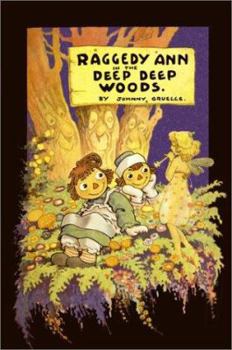Raggedy Ann in the Deep Deep Woods: Classic Edition
(Part of the Raggedy Ann and Andy Series)
Select Format
Select Condition 
Book Overview
It's a wonderful day in the deep, deep woods -- and full of surprises too! Join Raggedy Ann and Andy as they frolic with their woodland friends and use their magical wishing pebble to make everyone's... This description may be from another edition of this product.
Format:Library Binding
Language:English
ISBN:0689849702
ISBN13:9780689849701
Release Date:May 2002
Publisher:Simon & Schuster Children's Publishing
Length:95 Pages
Weight:0.90 lbs.
Dimensions:0.6" x 6.4" x 9.3"
Age Range:5 to 8 years
Grade Range:Preschool to Grade 3
Customer Reviews
1 rating
Rapt Within A Magic Ring
Published by Thriftbooks.com User , 21 years ago
Not that very long ago, it was fairly common, especially among the middle and upper classes, for parents in the United States to entertain their young children with pleasant stories of elves, goblins, and fairies. Though ultimately derived from European sources, these were not the fairy tales of Perault, Grimm, and Anderson, but looser, sometimes spontaneous stories explaining natural phenomena such as rainbows, autumn foliage, snow flakes, or spring flowers. These fairy stories, some which also came from immigrant European grandparents, were also a part of the larger American media culture, and books on the subject, such as 1951's The Golden Books Treasury of Elves and Fairies, could easily be found in libraries and kindergarten classrooms across the country. In addition to fireside and classroom fairy songs (such as 'White Coral Bells') and widely anthologized children's poems like James Whitcomb Riley's 'Little Orphan Annie' and 'The Pixy People,' there were an abundance of books like Johnny Gruelle's Raggedy Ann in the Deep Deep Woods (1930), the Oz books of L. Frank Baum, Ruth Plumly Thompson, and John R. Neill, and the 16 Brownie books of Palmer Cox. Also widely available were the equally popular 'flower fairy' picture book series by Cicely Mary Barker. Even the Brownies division of the Girl Scouts of America reflected the fairy mythology in its literature: to see a helpful brownie, a young girl need only look into a pond or stream under a full moon, and the brownie--in fact the young girl's own reflection--would magically appear. During the first half of the 20th century, Santa Claus was commonly depicted as surrounded by toy-making elves with pointed ears in his North Pole estate, and knee-hugging, green or red Christmas pixies were common holiday toys and tree ornaments. Early 20th century Halloween post cards imported from Germany depicted the natural world as a place teeming with mischief-making boogies, goblins, and elves of every shape and color. Most American children were familiar with the tooth fairy, and the Sandman, who brought sleep to children on a nightly basis, was a kind of fairy too. In the advertising world, elves sold everything from Keebler cookies and Coca-cola to Bacardi Rum. By the fifties, however, America was rapidly moving away from its agricultural roots and the romantic sensibility that had dominated the arts for generations and given rise to these tales and images. By the end of the fifties, most children were still familiar with the Disney film interpretations of the Snow White (1938) and Cinderella (1950) tales, and recognized Tinkerbell, at the opening of each segment of the Wonderful World of Disney, as a fairy, if not as the single fairy character in Disney's adaptation of J. M. Barrie's Peter Pan (1951). By the late Fifties and into the Sixties, Disney was producing movies like Sleeping Beauty, Darby O'Gill and the Little People (both 1959), and The Gnome Mobile (1967). In Sixties television p




